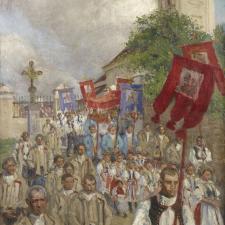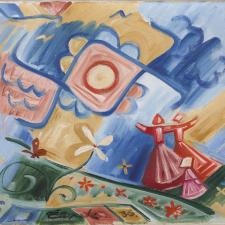Folk culture covers a quite heterogeneous variety of folk art. This exhibition is the first to examine the relationship between folk culture and fine art in the Czech Lands from the early 19th century to the latter half of the 20th century. It highlights the culture of country people, which played a much more crucial role in Czech art than popular culture from the urban environment.
From the mid-19th century onwards folk art became in effect an official and universal screen onto which individuals, groups, institutions and the state could project their political, social and cultural ideals. Folk art was manipulated or exploited in all kinds of ways to serve various purposes. The initial large-scale attempts to revive folk culture, whether under the pretext of “Czechoslavic” ideals (in the latter half of the 19th century) or the “Czechoslovak” national identity (during the First Republic) were based on similar fictions: they viewed rural society and the distinctive features of its culture as the foundation for a modern nation and the cultural identity it sought. Folk art was often treated as an artificial construct in the services of a nationalistic defence of the national community.
Folk art simultaneously served as the direct inspiration for a particular kind of art that came to be known as artistic folklore, although this embraced the most diverse subtexts and meanings. The different ways of approaching and manipulating elements taken from folk art and culture ranged from the simple observing and illustrating of the rural environment to subtle and very carefully thought-out interpretations. Artists frequently used the strategy of appropriating various forms of folk art by quoting them or transforming them to serve new ends in a new context.
The exhibition covers these aspects in thematic blocks with overlapping timespans. The installation of paintings, drawings, sculptures, photographs and films has been designed as a dynamic structure with intersecting layers. The ambition is not to provide an exhaustive account, but to trace any present-day resonances. Alongside works by more or less well-known artists from the period covered (Josef and Quido Mánes, Václav Kroupa, Wenzel Berger, Jaroslav Čermák, Antoš Frolka, Jaroslav Augusta, Joža Uprka, Josef Čapek, Zdenek Rykr, Emil Filla, Jaroslav Vodrážka and others), the exhibition also includes contemporary work by Anna Hulačová, Jan Vytiska, Barbora Lungová, Lenka Klodová, Daniela Baráčková and other artists who draw on folk culture.
The exhibition is accompanied by an extensive monograph published by Artefactum and Arbor vitae that is the outcome of the Czech Science Foundation’s project “Folk art between visual culture and politics in Bohemia and Moravia: 1840–1960”. The authors are Vladimír Czumalo, Pavla Machalíková, Milan Pech and Tomáš Winter.
The exhibition will reflect the subject of the 39th Pilsen Symposium on the 19th Century: the genesis of the folk in 19th-century Czech culture.
|
|






